gunga
Flashaholic
For consideration for the reviews sub forum.
Portinga Products Firefly Prototype Review
Please note: This review will continue to evolve as I gather more data and pictures. I will continue adding to the review when possible.
This is a review of a prototype of the Portinga Products Firefly flashlight, also known as the "Kickstarter Light". A sample was purchased for this review. No payment of any kind was accepted for the review.
The current Kickstarter campaign can be found here:
https://www.kickstarter.com/projects/2112614854/firefly-flashlight?ref=project_link
More information on the creator, Josh Portinga, can be found here:
http://portingaproducts.com/
Summary
Overall, this is a very good light (prototype). The host is well machined with an innovative heatsink design for better heat shedding. The rectangular knurling is VERY grippy.
The milled clip is a work of art that clamps firmly and consistently.
The UI (User Interface) is simple and effective with well-chosen levels.
The torch like tritium accents are both attractive and functional.
Things are not perfect however:
The creator (Josh Portinga) has been very responsive and creative in solving these issues. The Firefly will undoubtedly be a very fine and unique light once it goes to final production.
Background
A brief origin story. The Firefly came out of the unsuccessful electric eraser campaign.
https://www.kickstarter.com/project...ed-304-stainless-steel-electri?ref=nav_search
While that project did not meet its funding goal, conversations with one of the backers prompted the creator (Josh Portinga) to develop a high-end custom flashlight. It was thought that flashlights were obsolete due to the prevalence of smart phones.
Well, while a smart phone has many uses, it will always be a compromise. Those who desire top performance, utility, or style, will still buy high end objects: Watches, cameras, and of course, flashlights.
Thus was born the Firefly.
https://www.kickstarter.com/projects/2112614854/firefly-flashlight?ref=project_link
Unboxing
The package has arrived! DHL for fast delivery!
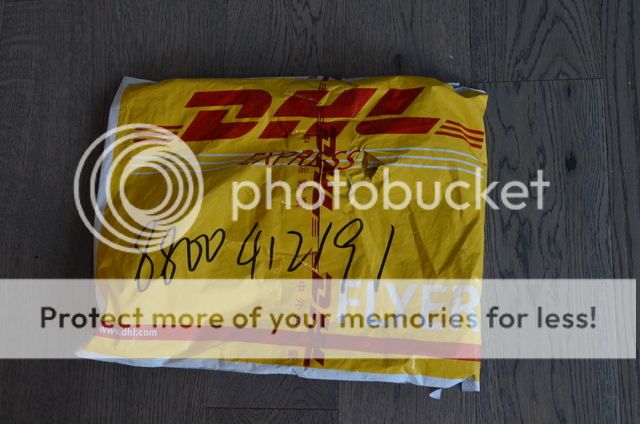
I gleefully opened up the package to find a well-padded cardboard box. Inside the box, two lights
(a dummy light with clip and a functional light) were loose and covered in thin fabric.
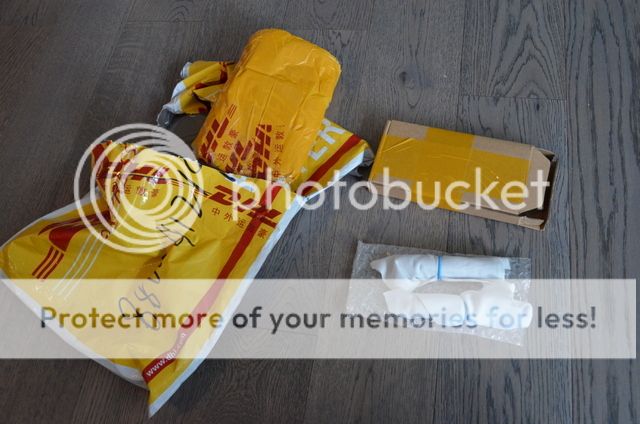
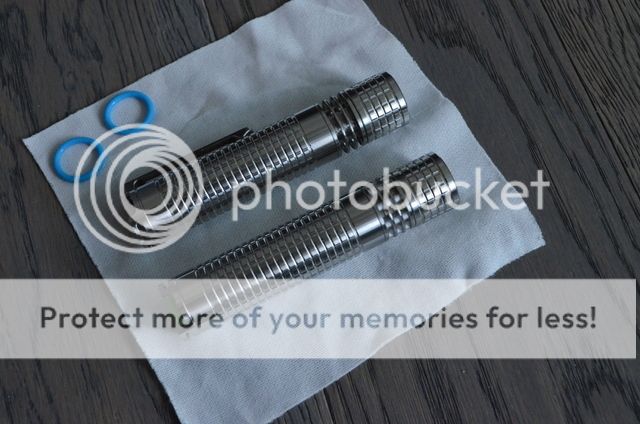
Unfortunately, this allowed them to bang into each other and resulted in two of the eight tritium vials being broken. This displays the main weakness of the design: large, fragile, tritium tubes. I will go over this in more detail in the "Tritium Features" section.
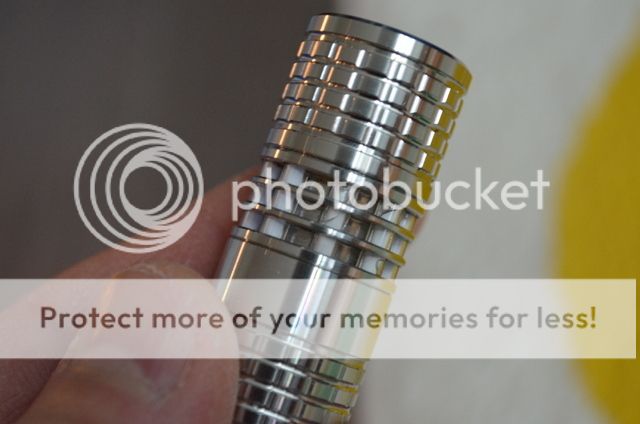
The clip is loose, so I shortened the bolts and installed the clip on the functional light to allow for true EDC (Every Day Carry) testing.
Host Quality
The machining on the host is impressive. The knurling is a rectangular pattern that is both attractive and uncommon. It is also very aggressive. The knurling ensures that one should be able to keep a firm grip on the light in all conditions. The aluminum version is likely to be a bit less aggressive due to the processing and anodizing, but the titanium and stainless models should both be quite sharp.
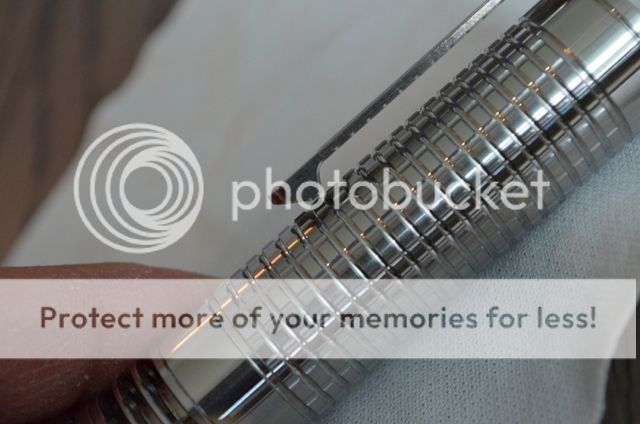
Here are some views of the light with the clip installed. Note the temporary clip hardware. The final product will thead directly into holes in the host (no nuts needed).
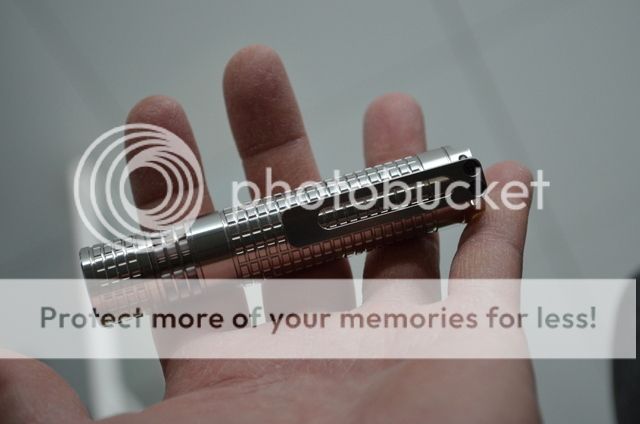
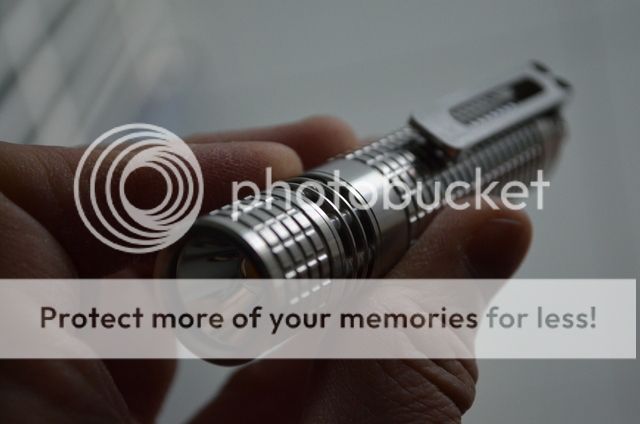
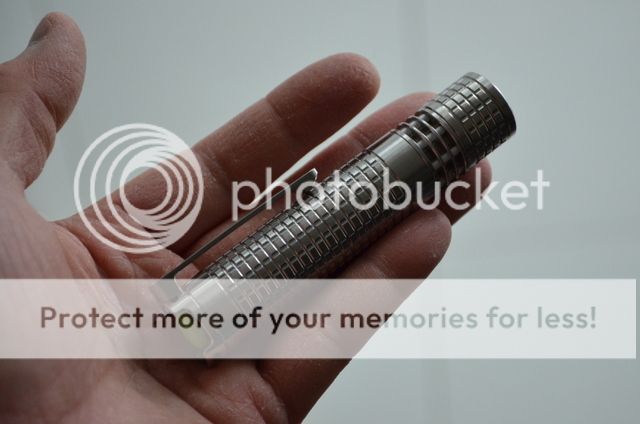
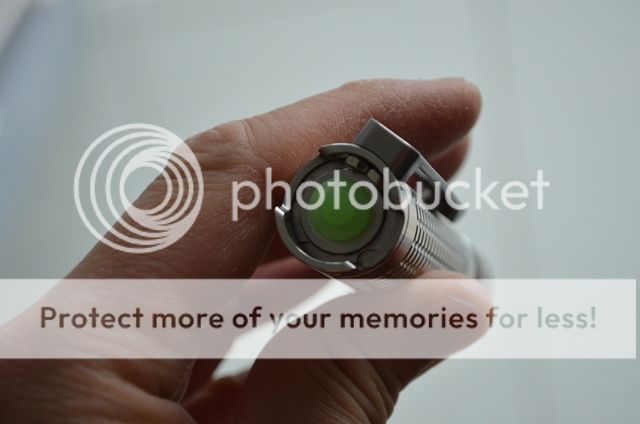
The threads were cut square and all pieces screwed together smoothly. The threads had a bit of slop but that should be fixed in the final version.
Here is the head disassembed. The red tape around the reflector is only in the prototype. It is used to insulate the reflector from the body.
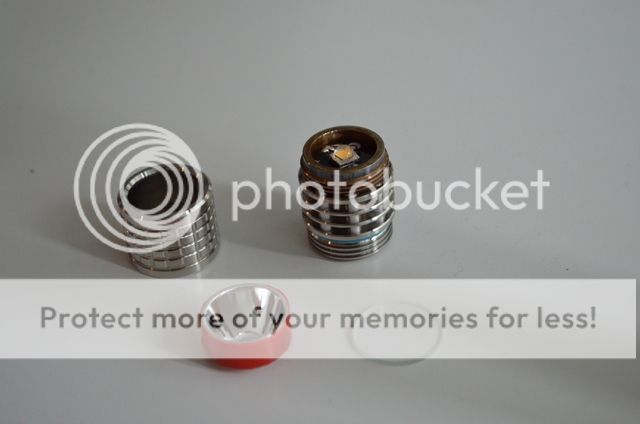
Yes, that is an AR coated lens.
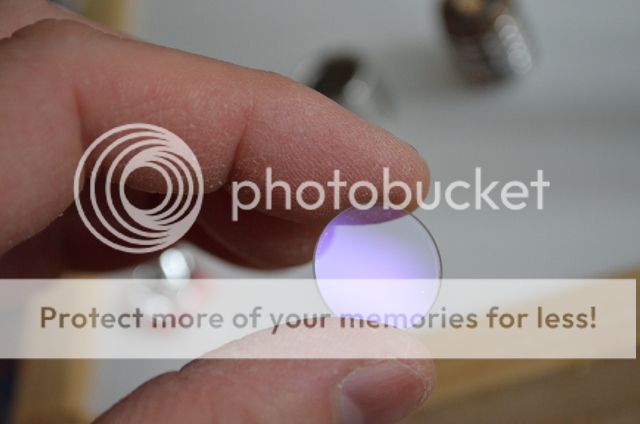
A nice, unique feature is that the LED thermal slug is soldered directly to the copper heatsink. This should promote great heat transfer to the host, keeping the LED nice and cool at high drive levels.
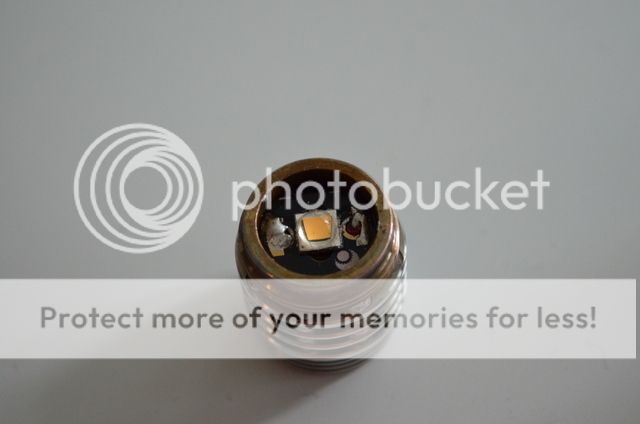
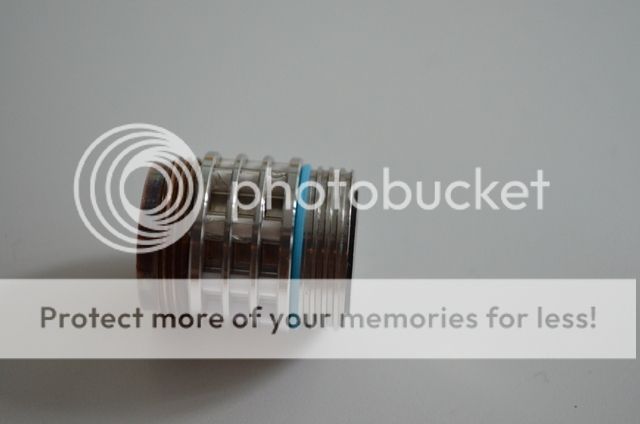
This is how it would look disassembled.
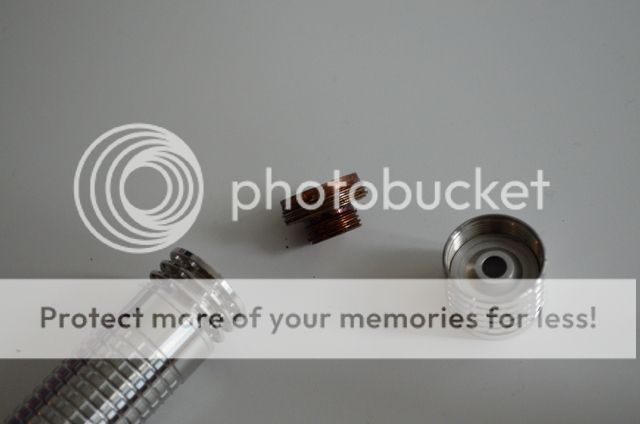
Overall, the host is very well put together and feels solid and hefty. The stainless model has a lot of weight to it. Those who want a more svelte light should choose the alloy or titanium model.
Size-wise, the light is a comfortable 97x20mm. This should be considered a mid-size light, around the size of a Fenix or 4Sevens AA light, but slimmer. It fits comfortably in the hand and is not too large to pocket.
This is the Firefly next to a Sunwayman M10A. Similar size to a Quark AA or Fenix equivalent.
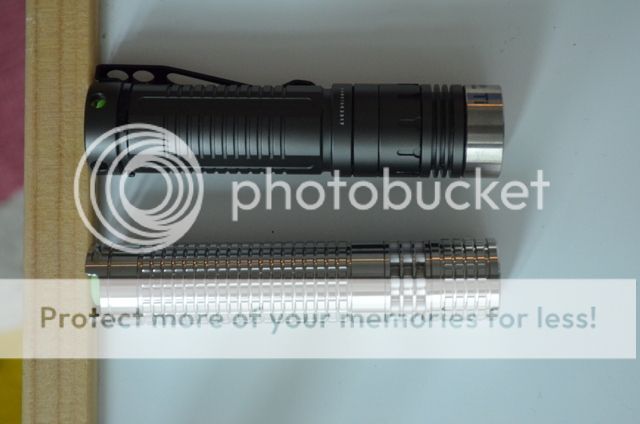
And next to a few common lights. So, from L-R: Olight S15R, Eagletac D25A, Firefly, Zebralight SC52w, Eneloop bettery.
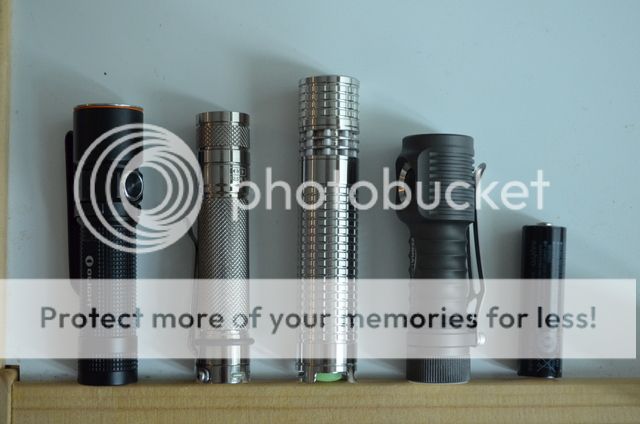
The switch boot cover is based on an uncommon size (10mm or so). I would have preferred a more standard size (14mm) but the switch worked well. The switch itself was a small Omten brand switch. They are reliable, easy to replace, and can handle high currents well (There are reports of usage over 5 Amps). The switch is a reverse clicky, and the feel is firm and crisp.
Here it is next to a common 14mm boot. Note, the final production version will have a black boot.
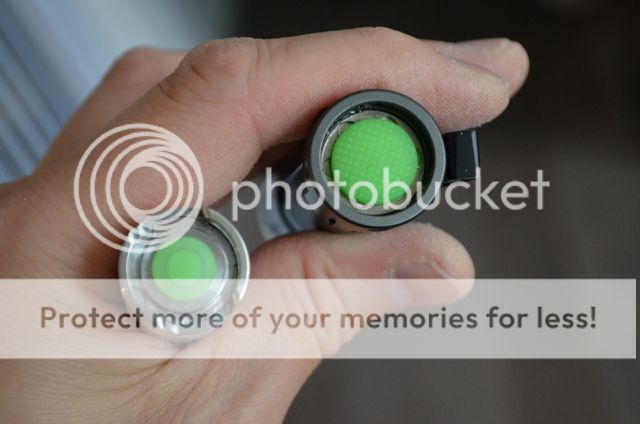
Clip Quality
The clip is quite a marvel, being both beautiful and functional. It is my first experience with a milled clip. The alloy is 6-4 (AKA Grade 5) Titanium with fantastic characteristics. The clip is very springy and firm. The strength of the clip coupled with the aggressive knurling on the light will ensure that it will not slip out of your pocket. It may, however, chew up the fabric of your pants. Keep this in mind in use.
Cosmetically, the clip is very elegant and unique. I do find it a bit large/wide for the light, but that is a matter of taste. It's definitely one of a kind. The hardware (bolts and nuts) that came with the clip were temporary and did not function well (they loosened up frequently and were too small to secure the clip reliably). Interesting, the clip continued to function well even with the existing hardware. The final version will be bolted directly into the body of the light and larger bolts are being incorporated.
Here are a few views of the clip on the dummy light before it was transfered to the functioning light.
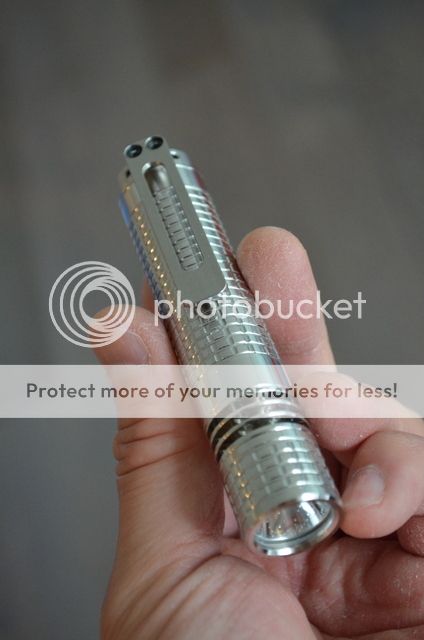
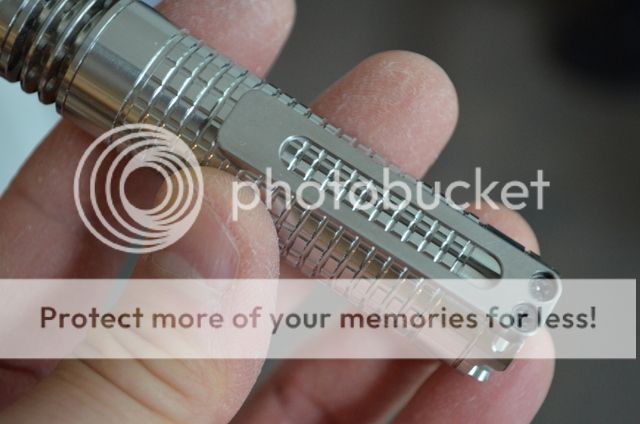
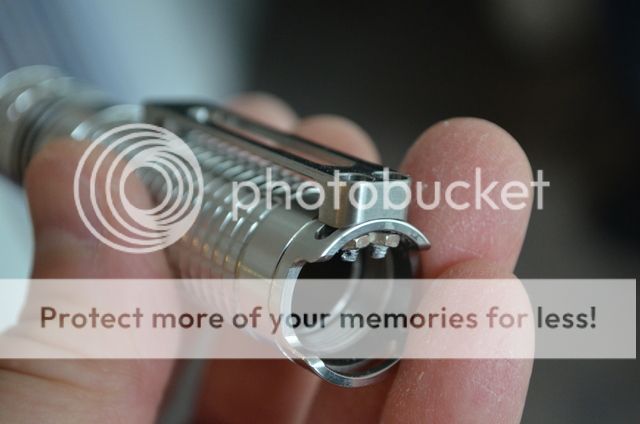
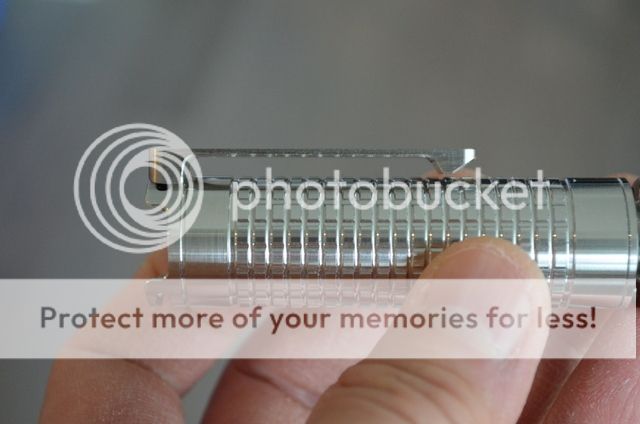
Beam Characteristics
The beam is a mixed bag. The smooth reflector is designed for a very wide spill and achieves this goal. While, overall, the beam is quite clean, I find the transition from spot to spill a bit abrupt. It may help with throw somewhat but I find makes close range use a bit less pleasant. That said, the spot is somewhat wide (it's definitely not a thrower). A textured reflector would be better suited for this light since it is intended to be a closer range, floodier light.
The LED is quite well centered in the smooth reflector.
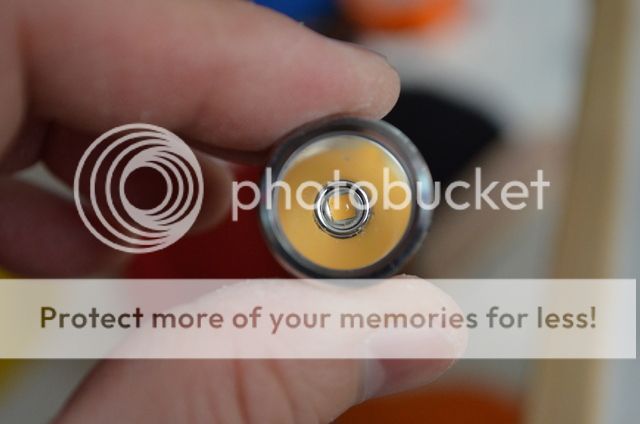
The beam is smooth but the hotspot is very distinct. Note, the walls are white but this is auto white balance.
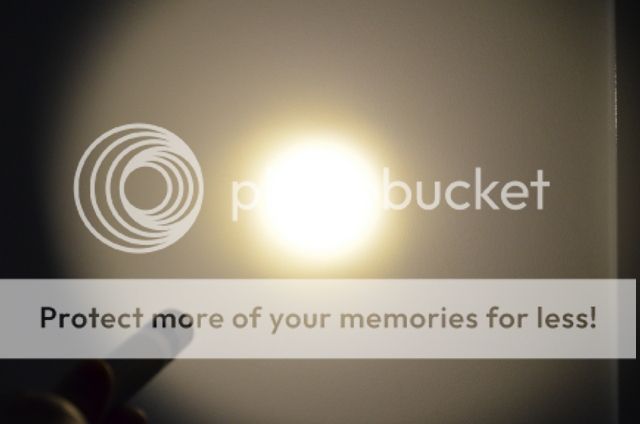
The tint is … warm. Very warm. The stated bin of the LED is XMLBWT-0-7D3-S50-0U-0001, a 90+ CRI 2900K XML2 LED, I just find it too warm. I can appreciate a warm white (High CRI) tint. My defacto warm tint standard is the 7A1/7B1 bins found in high CRI XPG LEDs. The colour temperature is around 3200K and it provides a soft, warm, beautiful light. In contrast, I found the Firefly to be far too yellow/orange with a slight hint of green. While it was not too unpleasant, it just added too much orange to objects, and always felt "dim". This was especially prevalent at lower drive levels since current controlled lights tend to produce warmer tint at lower levels. Luckily the LED choice is not final and will be changed. Other options are being considered.
So, the following pictures were taken with a Nikon D5100 SLR using daylight white balance.
All the lights have diffusion films over the lens to isolate tint from beam characteristics.
From L-R.
(Warm 2900K 7D3 tint XML2), High CRI XPG (Warm 3200K? 7A1 tint), High CRI Nichia 219A (4500K), and Neutral (4000K?) 5A tint XPL.
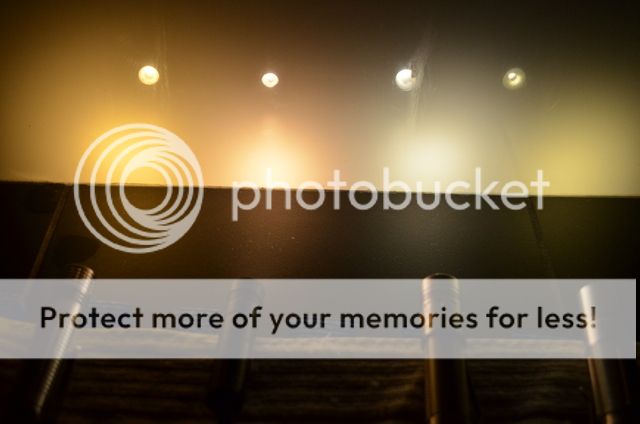
Here are my attempts to display the tint. The same camera settings were used. The towel was white.
This is the 7D3 tint in the Firefly. Very orange, always looked dim.
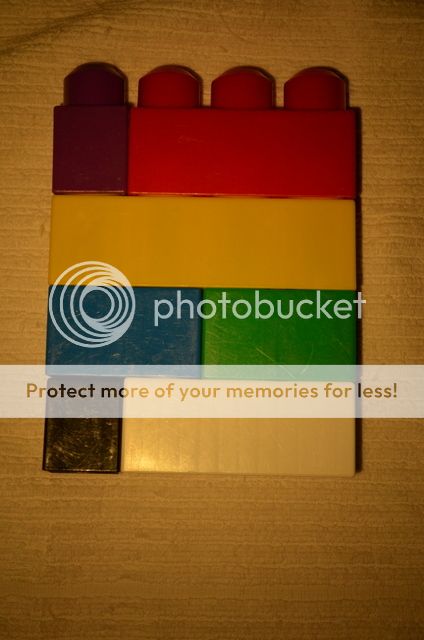
This is the 7A1 High CRI XPG. A bit more red, a lot less warm. I think around 3200K. I like this tint quite a lot in person.
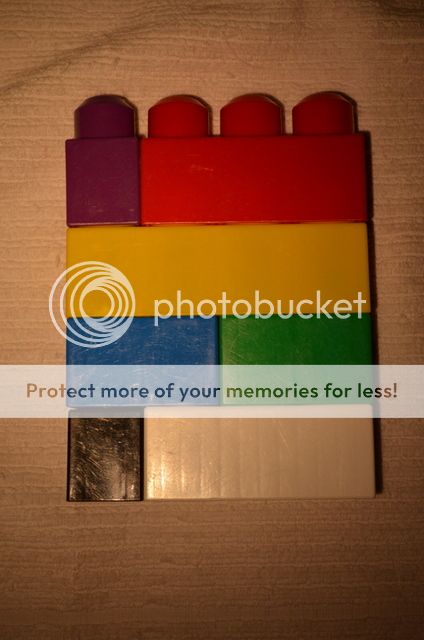
The Nichia 219A. High CRI, around 4500K. Known to be a bit rosy. Clean tint, one of my favorites. I like it better than the 219B (5000K) but it has lower performance and output.
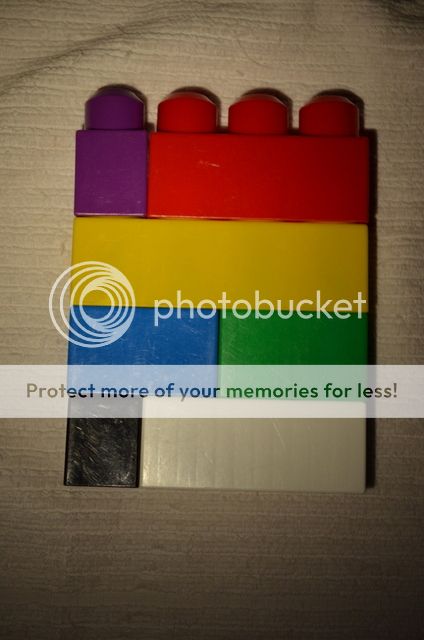
This is the 5A XPL. Looks greenish here but quite pleasant in person. This LED can provide the most output.
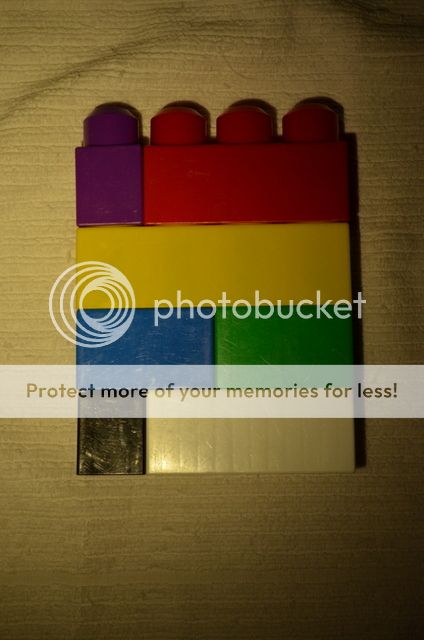
Levels/UI
The Firefly uses a very simple interface, with four levels. It always starts on low/moonlight (no mode memory) and increases levels with each half-press of the switch (reverse clicky). The light has a very short reset time (around ½ second) so getting back to moonlight is quick and easy. This is a very simple and intuitive interface. I found it to be very effective.
The four levels are quite well spaced, though the second level, after moonlight could be a touch lower for better visual spacing but, as is, the levels are quite balanced (using both battery types). The light is current controlled. No PWM is detected at any level.
I estimate the levels, when using nimh, to be around: 0.1 – 15 - 60 – 200 lumens. I would lower the second level to around 5-8 lumens.
I estimate the levels, when using 14500 (Lithium Ion) cells, to be around: 0.4 – 35 – 120 – 450 lumens. Again, I would lower the second level to around 15-20 lumens.
If one favours lower modes overall (like I do), nimh is the best choice. If one wants max output and is not too concerned about useful lower levels (3-20 lumen range), then 14500 cells are the best choice.
So, the circuit is a nice compromise. It offers a satisfyingly low moonlight mode with a potential 450 lumen max mode. It's too bad that more of the lower modes aren't accessible with 14500 cells but one can only do so much with 4 levels.
Heat Management
When running on max using a 14500 cell, the light became uncomfortably hot after a couple minutes. It seems the copper heatsink is doing its job, even with the stainless steel body (notorious for poor heat conduction). A titanium, and especially aluminum, model will run even hotter, but the LED will perform better and last longer.
When running on max using a nimh battery, the light became warm but was never too hot to hold. The lower drive levels on nimh didn't generate too much heat.
Tritium Features
The Firefly has one very special feature: very large tritium locators. It is designed to be easily located in the dark and the eight, very large, glowing (3x11mm) tritium vials will ensure this. These are huge vials, making the light seem like a mini lantern. The vials will glow for more than 10-15 years without charging of any kind. The trits are striking and beautiful; they are also very fragile. My light came with two broken vials. Considering how well they were packed externally, the damage must have been caused by the dummy light striking the test light. This was disappointing and a bit concerning. The vials are not user replaceable, they are sealed in the light. Future versions will have user replaceable vials.
Very bright. Very beautiful.
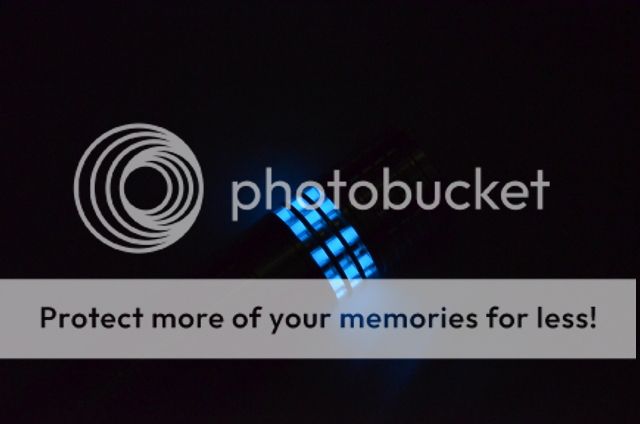
Drop Tests
I performed some quick drop tests to check for basic durability. The light was dropped three times from a height of three feet onto a hospital floor (linoleum over concrete). Whilst the light continued to function correctly, I managed to break two more tritium vials. The results of my testing has been sent to the designer who will look into some possible changes to better protect the vials. This will need to be solved before final production. Currently alternative designs are being tested.
The Path to Kickstarter and Final Thoughts.
Overall, this is a very promising prototype. The host is well machined, the clip is strong and unique, the interface is simple and effective, and overall, it is a solid light.
The findings of this review have been passed on to the designer. He has been very responsive and will incorporate refinements and updates that will optimize this light for its release on Kickstarter.
I look forward to seeing the final finished version. I know I will be a backer.
Portinga Products Firefly Prototype Review
Please note: This review will continue to evolve as I gather more data and pictures. I will continue adding to the review when possible.
This is a review of a prototype of the Portinga Products Firefly flashlight, also known as the "Kickstarter Light". A sample was purchased for this review. No payment of any kind was accepted for the review.
The current Kickstarter campaign can be found here:
https://www.kickstarter.com/projects/2112614854/firefly-flashlight?ref=project_link
More information on the creator, Josh Portinga, can be found here:
http://portingaproducts.com/
Summary
Overall, this is a very good light (prototype). The host is well machined with an innovative heatsink design for better heat shedding. The rectangular knurling is VERY grippy.
The milled clip is a work of art that clamps firmly and consistently.
The UI (User Interface) is simple and effective with well-chosen levels.
The torch like tritium accents are both attractive and functional.
Things are not perfect however:
- The LED choice is too warm which affects colour accuracy (2900K with strong orange tint).
- The tritium design leads to breakage of the fragile (and costly) vials.
- The knurling is sharp enough to wear out fabric and hands quickly.
- Various construction issues (minor) to be addressed before launch.
The creator (Josh Portinga) has been very responsive and creative in solving these issues. The Firefly will undoubtedly be a very fine and unique light once it goes to final production.
Background
A brief origin story. The Firefly came out of the unsuccessful electric eraser campaign.
https://www.kickstarter.com/project...ed-304-stainless-steel-electri?ref=nav_search
While that project did not meet its funding goal, conversations with one of the backers prompted the creator (Josh Portinga) to develop a high-end custom flashlight. It was thought that flashlights were obsolete due to the prevalence of smart phones.
Well, while a smart phone has many uses, it will always be a compromise. Those who desire top performance, utility, or style, will still buy high end objects: Watches, cameras, and of course, flashlights.
Thus was born the Firefly.
https://www.kickstarter.com/projects/2112614854/firefly-flashlight?ref=project_link
Unboxing
The package has arrived! DHL for fast delivery!

I gleefully opened up the package to find a well-padded cardboard box. Inside the box, two lights
(a dummy light with clip and a functional light) were loose and covered in thin fabric.


Unfortunately, this allowed them to bang into each other and resulted in two of the eight tritium vials being broken. This displays the main weakness of the design: large, fragile, tritium tubes. I will go over this in more detail in the "Tritium Features" section.

The clip is loose, so I shortened the bolts and installed the clip on the functional light to allow for true EDC (Every Day Carry) testing.
Host Quality
The machining on the host is impressive. The knurling is a rectangular pattern that is both attractive and uncommon. It is also very aggressive. The knurling ensures that one should be able to keep a firm grip on the light in all conditions. The aluminum version is likely to be a bit less aggressive due to the processing and anodizing, but the titanium and stainless models should both be quite sharp.

Here are some views of the light with the clip installed. Note the temporary clip hardware. The final product will thead directly into holes in the host (no nuts needed).




The threads were cut square and all pieces screwed together smoothly. The threads had a bit of slop but that should be fixed in the final version.
Here is the head disassembed. The red tape around the reflector is only in the prototype. It is used to insulate the reflector from the body.

Yes, that is an AR coated lens.

A nice, unique feature is that the LED thermal slug is soldered directly to the copper heatsink. This should promote great heat transfer to the host, keeping the LED nice and cool at high drive levels.


This is how it would look disassembled.

Overall, the host is very well put together and feels solid and hefty. The stainless model has a lot of weight to it. Those who want a more svelte light should choose the alloy or titanium model.
Size-wise, the light is a comfortable 97x20mm. This should be considered a mid-size light, around the size of a Fenix or 4Sevens AA light, but slimmer. It fits comfortably in the hand and is not too large to pocket.
This is the Firefly next to a Sunwayman M10A. Similar size to a Quark AA or Fenix equivalent.

And next to a few common lights. So, from L-R: Olight S15R, Eagletac D25A, Firefly, Zebralight SC52w, Eneloop bettery.

The switch boot cover is based on an uncommon size (10mm or so). I would have preferred a more standard size (14mm) but the switch worked well. The switch itself was a small Omten brand switch. They are reliable, easy to replace, and can handle high currents well (There are reports of usage over 5 Amps). The switch is a reverse clicky, and the feel is firm and crisp.
Here it is next to a common 14mm boot. Note, the final production version will have a black boot.

Clip Quality
The clip is quite a marvel, being both beautiful and functional. It is my first experience with a milled clip. The alloy is 6-4 (AKA Grade 5) Titanium with fantastic characteristics. The clip is very springy and firm. The strength of the clip coupled with the aggressive knurling on the light will ensure that it will not slip out of your pocket. It may, however, chew up the fabric of your pants. Keep this in mind in use.
Cosmetically, the clip is very elegant and unique. I do find it a bit large/wide for the light, but that is a matter of taste. It's definitely one of a kind. The hardware (bolts and nuts) that came with the clip were temporary and did not function well (they loosened up frequently and were too small to secure the clip reliably). Interesting, the clip continued to function well even with the existing hardware. The final version will be bolted directly into the body of the light and larger bolts are being incorporated.
Here are a few views of the clip on the dummy light before it was transfered to the functioning light.




Beam Characteristics
The beam is a mixed bag. The smooth reflector is designed for a very wide spill and achieves this goal. While, overall, the beam is quite clean, I find the transition from spot to spill a bit abrupt. It may help with throw somewhat but I find makes close range use a bit less pleasant. That said, the spot is somewhat wide (it's definitely not a thrower). A textured reflector would be better suited for this light since it is intended to be a closer range, floodier light.
The LED is quite well centered in the smooth reflector.

The beam is smooth but the hotspot is very distinct. Note, the walls are white but this is auto white balance.

The tint is … warm. Very warm. The stated bin of the LED is XMLBWT-0-7D3-S50-0U-0001, a 90+ CRI 2900K XML2 LED, I just find it too warm. I can appreciate a warm white (High CRI) tint. My defacto warm tint standard is the 7A1/7B1 bins found in high CRI XPG LEDs. The colour temperature is around 3200K and it provides a soft, warm, beautiful light. In contrast, I found the Firefly to be far too yellow/orange with a slight hint of green. While it was not too unpleasant, it just added too much orange to objects, and always felt "dim". This was especially prevalent at lower drive levels since current controlled lights tend to produce warmer tint at lower levels. Luckily the LED choice is not final and will be changed. Other options are being considered.
So, the following pictures were taken with a Nikon D5100 SLR using daylight white balance.
All the lights have diffusion films over the lens to isolate tint from beam characteristics.
From L-R.
(Warm 2900K 7D3 tint XML2), High CRI XPG (Warm 3200K? 7A1 tint), High CRI Nichia 219A (4500K), and Neutral (4000K?) 5A tint XPL.

Here are my attempts to display the tint. The same camera settings were used. The towel was white.
This is the 7D3 tint in the Firefly. Very orange, always looked dim.

This is the 7A1 High CRI XPG. A bit more red, a lot less warm. I think around 3200K. I like this tint quite a lot in person.

The Nichia 219A. High CRI, around 4500K. Known to be a bit rosy. Clean tint, one of my favorites. I like it better than the 219B (5000K) but it has lower performance and output.

This is the 5A XPL. Looks greenish here but quite pleasant in person. This LED can provide the most output.

Levels/UI
The Firefly uses a very simple interface, with four levels. It always starts on low/moonlight (no mode memory) and increases levels with each half-press of the switch (reverse clicky). The light has a very short reset time (around ½ second) so getting back to moonlight is quick and easy. This is a very simple and intuitive interface. I found it to be very effective.
The four levels are quite well spaced, though the second level, after moonlight could be a touch lower for better visual spacing but, as is, the levels are quite balanced (using both battery types). The light is current controlled. No PWM is detected at any level.
I estimate the levels, when using nimh, to be around: 0.1 – 15 - 60 – 200 lumens. I would lower the second level to around 5-8 lumens.
I estimate the levels, when using 14500 (Lithium Ion) cells, to be around: 0.4 – 35 – 120 – 450 lumens. Again, I would lower the second level to around 15-20 lumens.
If one favours lower modes overall (like I do), nimh is the best choice. If one wants max output and is not too concerned about useful lower levels (3-20 lumen range), then 14500 cells are the best choice.
So, the circuit is a nice compromise. It offers a satisfyingly low moonlight mode with a potential 450 lumen max mode. It's too bad that more of the lower modes aren't accessible with 14500 cells but one can only do so much with 4 levels.
Heat Management
When running on max using a 14500 cell, the light became uncomfortably hot after a couple minutes. It seems the copper heatsink is doing its job, even with the stainless steel body (notorious for poor heat conduction). A titanium, and especially aluminum, model will run even hotter, but the LED will perform better and last longer.
When running on max using a nimh battery, the light became warm but was never too hot to hold. The lower drive levels on nimh didn't generate too much heat.
Tritium Features
The Firefly has one very special feature: very large tritium locators. It is designed to be easily located in the dark and the eight, very large, glowing (3x11mm) tritium vials will ensure this. These are huge vials, making the light seem like a mini lantern. The vials will glow for more than 10-15 years without charging of any kind. The trits are striking and beautiful; they are also very fragile. My light came with two broken vials. Considering how well they were packed externally, the damage must have been caused by the dummy light striking the test light. This was disappointing and a bit concerning. The vials are not user replaceable, they are sealed in the light. Future versions will have user replaceable vials.
Very bright. Very beautiful.

Drop Tests
I performed some quick drop tests to check for basic durability. The light was dropped three times from a height of three feet onto a hospital floor (linoleum over concrete). Whilst the light continued to function correctly, I managed to break two more tritium vials. The results of my testing has been sent to the designer who will look into some possible changes to better protect the vials. This will need to be solved before final production. Currently alternative designs are being tested.
The Path to Kickstarter and Final Thoughts.
Overall, this is a very promising prototype. The host is well machined, the clip is strong and unique, the interface is simple and effective, and overall, it is a solid light.
The findings of this review have been passed on to the designer. He has been very responsive and will incorporate refinements and updates that will optimize this light for its release on Kickstarter.
- The LED will likely be changed to something cooler and more neutral in tint.
- The signature feature, the huge tritium vials, will be re-designed to prevent breakage and allow users to change the vials.
- The clip will be slimmed down and use larger bolts for better durability.
- The knurling will be softened to cause less damage to fabric (and skin!).
- Numerous other updates will be incorporated into the design. They are relatively minor but will definitely enhance the light's usability and reliability.
I look forward to seeing the final finished version. I know I will be a backer.
Last edited:

